Northleach, Gloucestershire
Up to 1834
Northleach established a workhouse in about 1724 but it had closed by the 1750s, with the parish reverting to giving only out-relief. A new workhouse was opened in 1795 at Millend, where the inmates were initially employed in spinning.
After 1834
Northleach Poor Law Union was formed on 18th January 1836. Its operation was overseen by an elected Board of Guardians, 33 in number, representing its 30 constituent parishes as listed below (figures in brackets indicate numbers of Guardians if more than one):
County of Gloucester: Aldsworth, Aston Black, Bibury, Chedworth, Coln Rogers, Coln St Aldwyn, Coln St Dennis, Compton Abdale, Dowdeswell, Eastington, Eastleach Martin, Eastleach Turville, Farmington, Hampnett, Hasleton, Little Barrington, Northleach (2), Salperton, Sevenhampton, Sherborne, Shipton Oliffe, Shipton Solars, Southrop, Stowell, Turkdean, Winson, Whittington, Windrush, Withington, Yanworth.
The population falling within the Union at the 1831 census had been 10,019 with parishes ranging in size from Howell (population 43) to Chedworth (1,026) and Northleach itself (795). The average annual poor-rate expenditure for the period 1833-35 had been £6,066 or 12s.1d. per head of the population.
The new Northleach Union workhouse was built at the east end of Northleach in 1836. The Poor Law Commissioners authorised an expenditure of £3,650 on construction of the building which was intended to accommodate up to 200 inmates. It was designed by George Wilkinson who was the architect of many other Union workhouses including nearby ones at Witney, Chipping Norton and Stow on the Wold. His design for Northleach was a cut down version of the model square plan published by the Commissioners in 1835. The workhouse location and layout are shown on the 1887 map below.
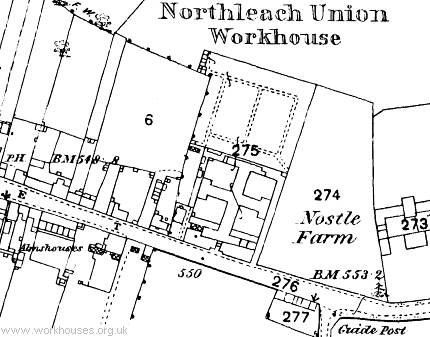
Northleach workhouse site, 1887.
The workhouse had an entrance block at the south which would have contained a porter's room and the Guardians' board room. At the rear, four accommodation wings for the various classes of inmates (infirm/able-bodied, male/female etc.) radiated from a central supervisory hub. The areas between the wings formed segregated exercise yards.
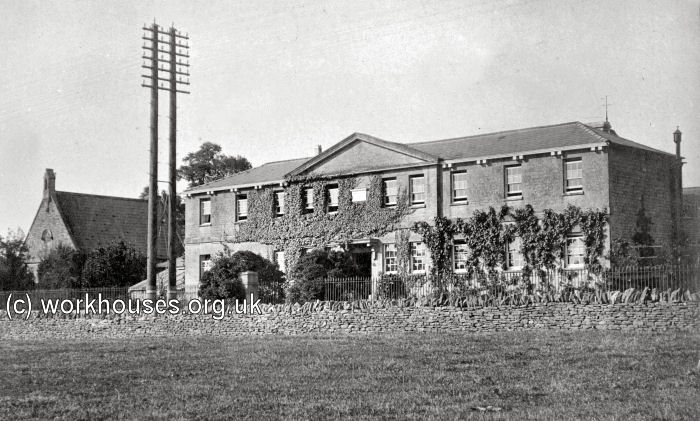
Northleach workhouse from the south-east, early 20th century.
© Peter Higginbotham.
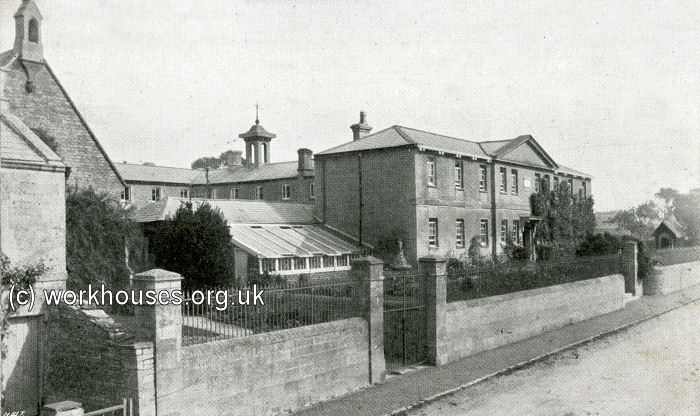
Northleach workhouse from the west, early 20th century.
© Peter Higginbotham.
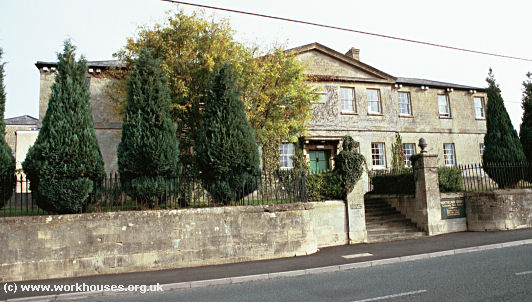
Northleach entrance block from the south, 2000.
© Peter Higginbotham.
Above the front entrance is a date plaque, probably dating from the 1920s when the workhouse was officially known as Northleach Poor Law Institution.
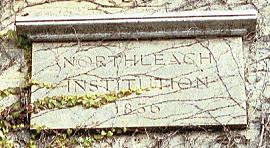
Northleach entrance date plaque, 2000.
© Peter Higginbotham.
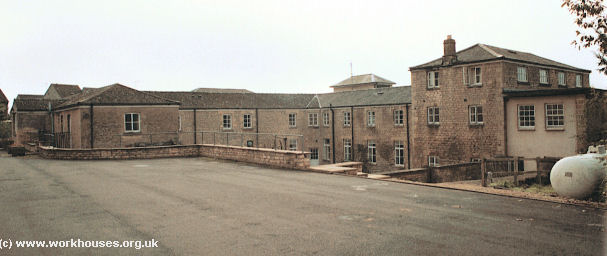
Northleach general view from the north-west, 2000.
© Peter Higginbotham.
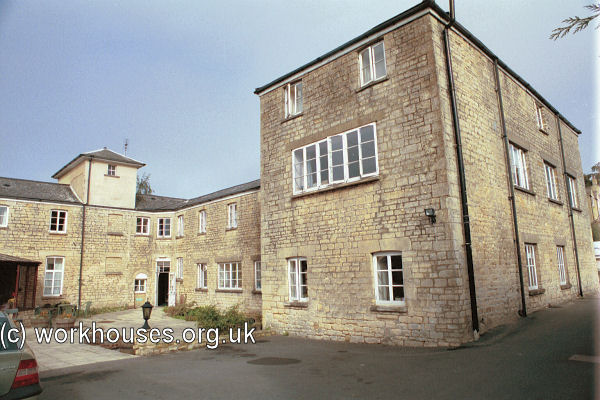
Northleach east wing from the south-east, 2000.
© Peter Higginbotham.
By 1867, a chapel had been erected at the south-west of the workhouse.
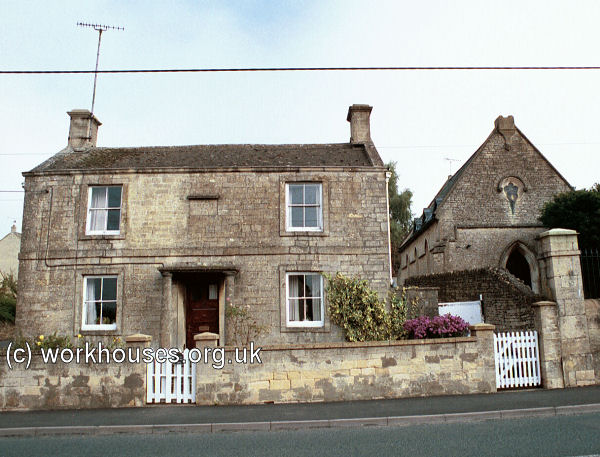
Northleach chapel (right) from the south-west, 2000.
© Peter Higginbotham.
In November 1867, the workhouse was the subject of an inspection report by the British Medical Journal, which found much to criticise. The old men's day room was described as 'bare and stony cell', the only furniture being a table and two forms without backs. The floor consisted of large stone slabs, broken and uneven, and the windows had no blinds. The young men's day room contained only three very old men, of whom two were picking oakum, and one feebly darning a pair of braces. This room, like the previous one, was whitewashed, with about its lower half coloured a dirty pink, giving the whole a dull and tawdry look. There were windows on both sides, 6 ft. 8 in. from the ground, precluding sight out. There was no house library. Both these rooms were 'dirty, ill kept, and desolate'. The able-bodied women's ward contained seven women. Four of the women were single mothers, while the other 'able-bodied' women were senile imbeciles. The girls' accommodation was good, however, with the thirteen inmates engaged in sewing. The only two boys in residence were taught with the girls. The vagrants' ward, at the west end of the frontage, received the greatest condemnation. It comprised a one-stalled stable, with no bath or drainage. The bedding consisted of old straw on the floor and thee old tattered counterpanes. The only convenience was a large open tub in the corner. Vagrants were given no supper and only a scanty breakfast before being required to break a bushel of gravel or pick a pound of oakum. The high spot of the inspectors' visit was the workhouse kitchen, where 'the bread, cheese, milk, and beer, were so good that we did more than taste them.' Further details are available in the full report.
In 1868, the vagrants' ward was moved to some unused cells at the town's police station, which occupied part of the old prison building at the north-west of Northleach.
In 1930, the workhouse site was taken over by Gloucestershire County Council and redesignated as a Public Assistance Institution, with seventy-two beds. The establishment later became Northleach Hospital. It is now used as a care home for the elderly
In 1868, following the BMJ's criticism, the casual ward was transferred to some unused cells in the town police station, which occupied part of the old prison building at the north-west of Northleach.
In 1930, the site was taken over by Gloucestershire County Council and was redesignated as a Public Assistance Institution with 72 beds. The establishment later became Northleach Hospital. It is now used as a care home for the elderly.
Staff
Inmates
Records
Note: many repositories impose a closure period of up to 100 years for records identifying individuals. Before travelling a long distance, always check that the records you want to consult will be available.
- Gloucestershire Archives, Clarence Row, Alvin Street, Gloucester GL1 3DW. Few records survive — holdings include Guardians' minute books (1875-1937); Ledgers (1870-1911); etc.
Bibliography
- Higginbotham, Peter The Workhouse Encyclopedia (2014, The History Press)
Links
Unless otherwise indicated, this page () is copyright Peter Higginbotham. Contents may not be reproduced without permission.


